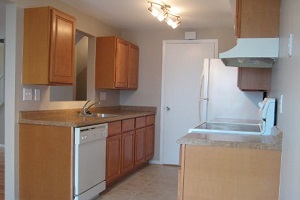
I mentioned yesterday that not only was I planning to restart this blog/website, but that we were also planning to focus some of our efforts on building a long-term rental portfolio. We actually purchased our first long-term rental property about a year ago, but are just getting our first tenants in this week…I’m going to use this post to catch you up on all the details, the pictures, the financials and the expectations for this deal. I’ve also set up an “Our Rentals” Page, where I’ll continue to track all the expenses, income and financial details of this property long-term.
Analyzing Buy-And-Hold Deals (FREE EBOOK!)
Before we delve into the details of this deal, it’s important to understand how buy-and-hold deals are typically analyzed and evaluated. Unlike flip deals — where the important question is “How much profit will I make!??!” when it comes to buy-and-hold deals, the more important question is, “What will my return on investment (ROI) be?”
There are many different ROI measurements that can be used, and better understand how ROI is typically evaluated for rental properties, I turned a tutorial I created several years ago into a Kindle eBook that discusses the topic in detail.
You can download the free eBook here (all I ask in return is that you leave an Amazon review for me when you’re done reading):
An Introduction to Real Estate Investment Deal Analysis
The goal was to make the Kindle book free forever, but Amazon doesn’t allow that — the best I could do is to make it free for a short promotional period (the next 72 hours), and then after that, I’m forced to charge the minimum, $.99. So, please download it now!
If you have any general questions about analyzing deals, feel free to shoot me an email or post a comment below.
Background on the Deal
At the beginning of 2014, I received an email through a local real estate investor group mailing list. The email was as follows:
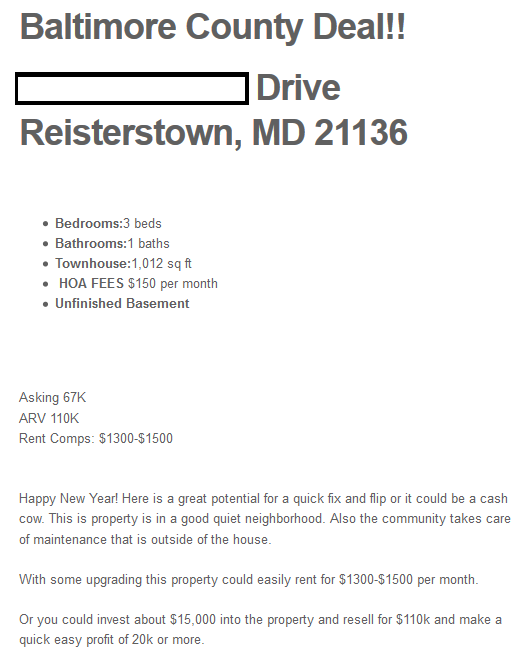
Now, I always assume the numbers in a wholesale ad are inflated, but I jumped onto Zillow and the MLS, and a quick seach indicated that the ARV was probably pretty reasonable (I got about $107K). While the rehab estimate was probably a little low based on the pictures and based on the fact that the basement would need to be finished to hit that ARV, some quick number crunching indicated that it might make an average flip deal if I could get it for a few thousand less than asking.
In addition, while I had no idea if the rental numbers were accurate, if they were, it didn’t take a complicated spreadsheet to realize that this property could hit the “2% rule” and make a great rental as well. I immediately emailed the wholesaler and asked if I could see the property. She said we could the next day at 3:00pm, which worked for my wife and me, so we scheduled a meeting for the following day.
The next day, my wife and I met the wholesaler at the property…the sellers were there as well. The house was owned by an older woman who passed away, and her daughter and son-in-law were looking for a quick sale.
We did a quick walk-through (I never like walking through with sellers in the house), and everything seemed very straightforward. It was a 3/1 (all on the second floor) built in the late 1970s, with a living room, eat-in kitchen area, small galley kitchen and walk-in pantry on the main level and an unfinished basement. The first two levels were just over 1000 square feet, and the basement (which was very clean) was about 500 square feet.
The townhouse is in an HOA community, and the HOA is responsible for all exterior maintenance. The roof was less than 5 years old, the vinyl siding was in great shape and despite all the recent snow, the walks were perfectly clean and clear (all a good sign). On the interior, the house was in very good shape, though it needed a full cosmetic renovation. The HVAC was less than 10 years old, the water heater was less than 4 years old, and the plumbing/electrical all looked to be in good shape.
Based on the rental numbers the wholesaler threw out ($1300-1500/month), I decided that we’d need to buy the property for under $60,000 to make it a great rental. My wife and I walked outside with the wholesaler and told her that we’d need it for $58,000 for it to work for us (she had mentioned a sale price of $67,000). She said she’d talk to the sellers, see what she could do and get back to me.
About an hour later, she called to tell me that $58,000 would work, and would send a contract over in the next 24 hours along with all the title company and closing information.
Analysis of the Deal
Here were the numbers as best as I could figure at the time:
- Purchase Price: $58,000
- Closing Costs: $2,000
- Rehab Costs: $20,000
For a total purchase and renovation costs of about $80,000.
A little bit of investigation indicated that I could probably rent the property for between $1400-1500
And doing some more research, I determined that my annual expenses would look a little bit like this:
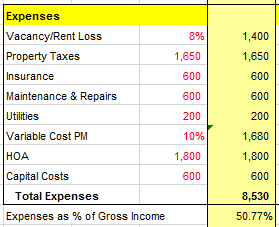
The expenses analysis was right about where I would have expected it to be based on the “50% Rule,” so that was a good indication that the numbers probably weren’t too far off.
Based on the purchase/rehab costs, the potential income and the likely expenses, here is what the analysis of the deal looked like if we paid all cash and didn’t get a loan on the property:

Not too bad — that’s over 10% return without any leverage. With a loan on the property, I had a feeling the numbers would look even better!
And they did. Assuming we could refinance out 80% of our investment after 6-12 months using a typical portfolio loan (small bank investment loan), here’s what our returns would look:

That’s nearly a 19% return…that’s a great deal in today’s market, at least in my area and for an almost completely passive deal. So, we decided to buy it, and closed on the purchase in January 2014.
Pictures & Renovation
Here is what the house looked like when we bought it:
Over the next 6 weeks or so, we did a full cosmetic renovation, including knocking a hole in the wall between the kitchen and living room and finishing the basement. We spent just over $18,000 for the rehab, broken down as follows:
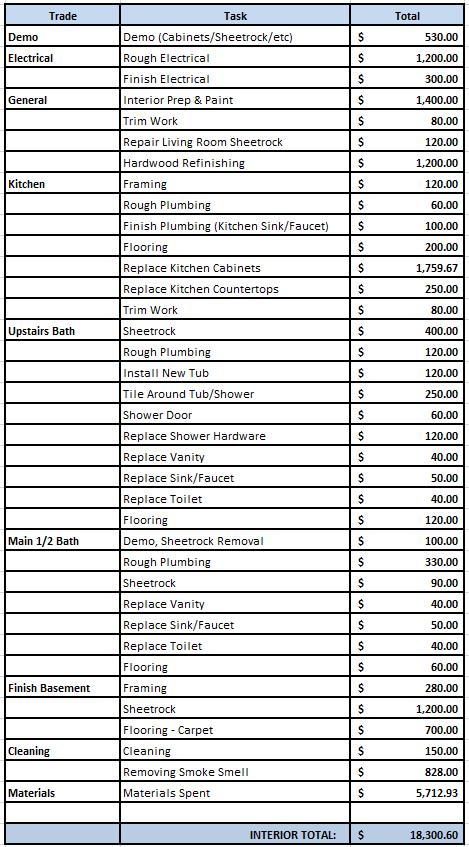
After the rehab, this is what the property looked like:
Getting It Rented
Unfortunately, the momentum stopped in March 2014, after we got the property rehabbed. I spent about a month trying to get the property rented myself (without a property manager), but given that it was about 45 minutes from my house — and given that we were in the process of building our personal residence at the time — I just didn’t have the energy to keep driving back-and-forth to meet and screen tenants. I kept thinking I’d get around to getting a tenant in there, but it never happened.
Then, on January 1, 2015, I finally decided it was time to hire a property manager. I found a reputable company in my area, turned over the listing to them on New Year’s day, and they agreed that $1450/month was the right number to be asking. It was a very bad time of year to try to find new tenants (especially given all the snow we’ve had this winter), so it took about 6 weeks to find qualified renters. But, by mid-February, they had tenants lined up. It’s a one-year lease at $1450/month (tenants pay all utilities), and they moved in this past weekend, on February 28.
Current Analysis
Now that we have all the numbers leading up to the house being rented, we can run another analysis using the actual numbers, and hopefully it’s pretty close to our original analysis. Here’s what the new analysis looks like:

We’re a little better than our original pro-forma analysis, at about 11% return. Then, if we assume we will refinance at some point soon using the same terms as in our original analysis, the numbers look like this:

That’s over 22% leveraged return, which I’m thrilled with!
Now, all that said, there are other ROI numbers I like to look at with every analysis. I’m not going to jump in to those here, but over the next couple of posts, I’ll detail some additional analysis I’ve done on the deal.

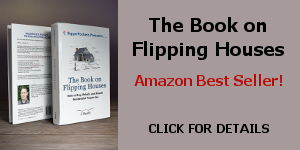
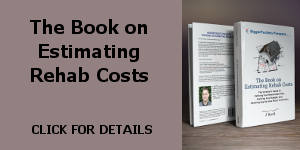

hi J!
i tried to download the book from amazon and since i dont have kindle, i couldn’t. “read it for free” takes you to their “download kindle” page. Just letting you know. would it be availble in PDF by any chance?
that’s a great recap, btw. i have no luck trying to rent it myself, so we just hire an agent to put it on the MLS. then we interview tenants and manage ourselves.
J,
Excellent reading as always and so glad you have settled into the new home. I enjoyed reading the article and went through the entire book just now. Very good read (aside from the missing pictures). Thanks for all of your contributions!
Hi J. I love your detailed posts. One question about your financing scenario to boost your ROI….since you ARV should be in the $107,000 range, why not take a 75% LTV loan out to cover the refi fees and $80,000 out of pocket? On a 30 year amortizing loan instead of a 20, you would have the same cashflow and have no cash left in this deal….infinite return. Do you have different longterm equity goals (as opposed to the cashflow) that make you look at your scenario vs. the one I show? Love to learn about what factors you consider for investing strategies on both cashflow and long term exit plans.
Hey Mike,
First, I don’t know any type of financing I can get with the property held in my LLC that will provide a 30 year amortizing loan. The lenders I know will do a max 20 year amortization on a 5-10 year balloon; if there were a 25-30 year product available, I’d definitely consider that.
The only other consideration is that I don’t want to be overleveraged. I might consider pulling most of my cash out, but I like to be conservative, which is why I threw out that particular scenario. That said, I may get more aggressive when the time comes to actually pull money out! 🙂
You are so thorough in your project mgt! I get a lot out of your website – thanks! As I was looking at your numbers above – had a couple questions..
1. Do you do any of the labor in these projects or do you have a GC or do you act as one?
2. For example – the above list of expenses for the bathroom says you bought a vanity for $40, sink & faucet for $50 and a toilet for $50? I don’t really see any plumbing labor here either? Where/how do you get deals like that?
Hey May,
1. I typically sub everything out and manage it myself. I don’t do any of the rehab work myself.
2. All prices are labor only. The very final line is all the materials for the entire project.
Hey J what property management company did you go with? I am currently I need of a reputable property manager. Thanks.
Todd S.
Hey Todd –
Went with these guys: http://www.baymgmtgroup.com/
Hi Mr. J Scott,
How do you buy a toilet for $40? Contractor prices?
Here in upstate NY they are 80-100 bucks!
Thanks
Great post!
Henry,
See my response to May above…the prices are all just labor prices…all the materials are lumped together in the bottom row marked “Materials”.
So, the $40 is the labor price to install the toilet. The actual toilet cost is in the bottom row…
Hello Scott,
I am happy to hear you are back with this new project (rentals), do you buy the properties under your name or your company? what will be the benefit? if we buy under the company name and if we need a loan to buy it, it will be still under our personal credit, right?
Thanks!
Hi Pilar,
We typically buy under our company name. Yes, you’ll find that if you buy through your company, you’ll still have to give a personal guarantee on the loan — these days, there’s just no way around that. Also, I would recommend finding a lender before you buy — some lenders would prefer you buy in a company name; some would prefer you buy in your own name. Knowing what your lender prefers would make things easier later on when you’re ready to buy.
Jay,
Great post. Regarding expenses, are the costs for CAPEX much smaller than the about $150 per month number I have seen you use before? I assume that is what the HOA charges are though I thought HOA took care of more the basic expenses than unit expenses like a roof etc. though I could be wrong as I know nothing about HOA.
I am just curious because you are one of the few people I have seen use the fixed capex number that I think is prudent and that has been a major estimation issue for me as a newer investor in terms of getting the right ballpark number before a full inspection was done.
Anyway enjoy your BP posts and the blog posts as well.
Hey Charles,
I’ll typically use $50-100/month for capex, depending on the property. For this one, I’m using $50/month, as the HOA will cover all the exterior stuff — roof, siding, etc. So, capex will be relatively low for this property.
One more question about the return assuming refinance the property, the 22.49% doesn’t include the Improvements and closing cost amounts, right? why you didn’t consider those amounts? The HOA and the payment for the property manager is not included as expenses? just wondering.
Thanks!!
Hey Pilar,
Yes, the 22.49% assumes the entire purchase + closing cost + rehab expense. Notice the total cost is $79,360 — that’s a purchase of $58K, closing cost of about $3K and rehab of about $18K.
And the expenses are consistent through each analysis, and they include the HOA fees ($1800 per year) and the PM fees (10% of gross rent).
So, yes, that 22.49% is the real life number with all costs and expenses added in…
Jay just out of curiosity why so little? I saw a post of yours when i was trying to figure out what my capex number should be (for out of state investing so just for ballpark) and it laid out some great figures:
– Roof – Every 20 Years – $5000
– HVAC – Every 20 Years – $5000
– Hot Water Heater – Every 8 Years – $800
– Windows – Every 20 Years – $5000
– Appliances – Every 10 Years – $2000
– Flooring – Every 5 Years – $2000
Every 20 years I would spend about $29,000. That averages to about $1500/year over those 20 years, or about $125/month. It related to what I would say is a fairly average property and I added in a few items you missed above to get to $150 – $155 so I guess I was just curious why such as a low number since I use the $150 – $155 numbers when I look at a property because what you wrote above made sense.
Hey Charles,
I was just estimating when I did the analysis. But, if I were to break it down in detail, for this property, the numbers should look like this:
– Roof: Covered by HOA
– HVAC: $4000 every 20 years
– H20: $600 every 8 years
– Windows: $2500 every 20 years
– Appliances: Not Capitalized (Maintenance)
– Flooring: Not Capitalized (Maintenance)
– Electrical: $4000 every 25 years
– Plumbing: $4000 every 25 years
So, about $14,400K every 20 years. Or about $60/month.
Last question then I am just going to stop because I have already spent too much of your time. Would any of this change without an HOA (other than the roof) as I was referring more to the typical cost number you were using? Thanks.
Hey Charles,
The roof is obviously something that would change based on the HOA. Additionally, siding and upkeep of other basic exterior components (decks, porches) would be impacted without an HOA (the HOA covers those things). Outside of HOA, the big driver of Capex is size of the building — the larger the building, the more you’ll spend in Capex. HVAC replacement will be more expensive, a new roof will be more expensive, larger hot water heaters, more windows, more electrical/plumbing, etc.
How do you plan to organize your Capex build up amount with this first rental and with any future additions to the portfolio?
If this one property were, say, in it’s own LLC and had a separate Checking/Savings setup for it, then it would make sense that the Savings would hold both the security deposit and the approximate $60/mo added for future Capex costs. Then the Checking would house the standard yearly Opex costs that need to be paid as well as cut a check for the debt service or investor cashflow. If the Checking balance gets too high due low maintenance/turnover/etc, you could accelerate your Capex savings or pull the extra cash.
The only thing is this can be easy to overcomplicate, and if you expand to 3 or 10 properties within this LLC, that could could be tricky understanding how much is where and for what.
Or is it just simpler to have $5k (sec deposit included) sit in savings for each property for Capex big repair (refill this as soon as you pull from it), leave enough each month in Checking to meet Opex costs, and take the extra cashflow each month to pay debt service (or build up to reinvest/spend, if no debt).
I do something closer to the second option, sending extra unneeded CF to my main LLC (which manages the individual properties) to invest wherever it makes sense. But I wanted to get your thoughts/perspective/theory on what you might do, this might a good blog post topic. Thanks!
Hey Kurt,
We don’t have to worry about security deposit at all — we have a PM who collected and manages the deposit. And yes, we essentially do the second option you mentioned — we have a bank account for the LLC and the monthly income is deposited in that account. Monthly expenses are paid from that account, and we’ll let it grow to $5-7K for future CapEx. Once the account gets to $5-7K, we’ll start distributing the cash. And given that we’ll likely buy one or two more in this LLC, we’ll have to determine how much to keep in the account given the worst-case scenario of multiple CapEx expenses hitting at once across different properties. But, given that we can always move money in/out from other businesses, I’m not too worried about it — we have a good bit of reserves across all businesses to account for surprises like that.
Hey J I was just wondering, would you hold all of your rentals in one LLC or would you only hold a specific number in a single LLC? If you choose to create multiple LLC’s would you do let your attorney/CPA set them up for you or do it yourself? I’ve heard they’re not very difficult or time consuming to setup but I feel like this is one area I wouldn’t want to handle myself. Also, do you use IRR/MIRR or any other calculation that takes the time value of money into account when you do an analysis? Thanks!
Hey Corey,
I like to keep the total amount of equity that I have in any given LLC pretty low. In other words, I’d rather have 10 properties in an LLC with total equity of $100K than to have 5 properties in an LLC with total equity of $200K. The less equity you have, the less you stand to lose if you (or the LLC) gets sued. In fact, even if I had 1000 properties all mortgaged 100% (so no equity in any of them), there would be little risk to having all 1000 properties in the same LLC.
I typically set up my own LLCs. It’s not tough, and the part where I CPA comes in is defining how you’ll have them taxed (partnership, S-Corp or C-Corp). But, you can set up the LLC yourself before you know that information — that’s done through an IRS filing.
And yes, I always do an IRR (typically MIRR) calculation for any projects I plan to hold for more than a year.
Hi Scott,
Great analysis, and thanks for spending your precious time trying to help us new investors.
Quick question, how much did you pay the management company, was it just one time fee or do they also manage your rental property on regular basis for recurring monthly fees?
Hi Hannah,
They are managing the property for me full-time. They charge 8% of the collected rent monthly, plus one month’s rent to place the new tenant.
Oh I see, so that makes up your variable cost PM of 10%. Thanks Jay! You and your wife are awesome people!
Hi Scott,
In your analysis section of expenses, was the 10% PM just for monthly charge not including commission for finding tenants or did you know it was going to be 8% and added the 2% for commission?
Kind regards,
Stan
I expected the total cost to be around 10% (maybe a bit more). Most PM companies in this area charge 8%, plus a placement fee, so 10% is reasonable. Though in reality, it’s turning out to be closer to 11.5% over the past couple years and across several properties…
Thank you for sharing your personal experience! Starting out in the rental property business takes a leap of faith. It also takes a lot of time, energy, and money when you’re just starting out. However, learning from others’ experiences can make things a lot easier, especially if your goal is to build a bigger portfolio over time in order to achieve financial freedom. I am sure your readers will benefit from seeing your journey spelled out in such great detail. This will give them a better idea what it’s really like to start out as a landlord.